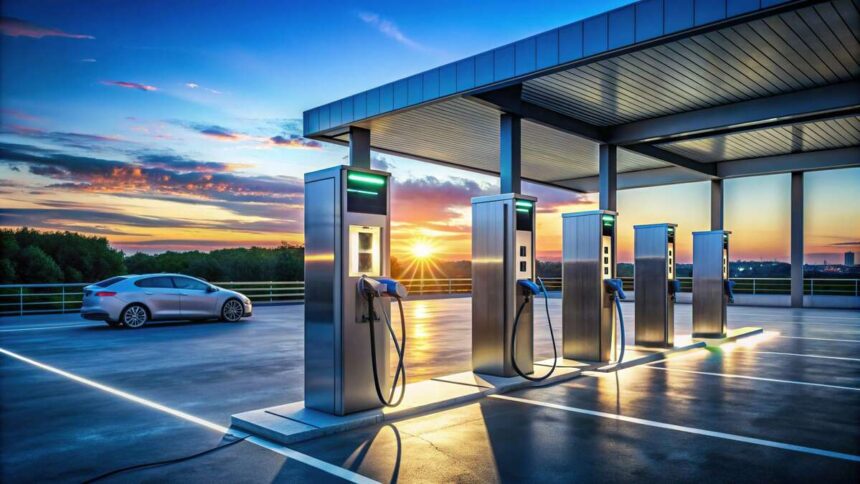Scanning media headlines, one might easily believe the electric vehicle (EV) market is on the verge of collapse. However, the market numbers tell a different story. Q3 data recently analyzed by Experian Automotive shows that in California, battery EVs comprise 22.2% of the state’s new car market share. When hybrids and battery EVs are combined, they account for nearly 40% of new car sales in the first nine months of 2024, more than triple what the number was in 2018. The IEA reports a similar trend globally.
Still, many folks are hesitant to trade the familiarity and convenience of an internal combustion engine vehicle for an EV. While EV performance is no longer in dispute, a lingering barrier to EV adoption remains ease and accessibility of charging stations. Charging at home is a great option for those who can make it happen, but for folks who don’t have that option or those who are out of range, safe, available, and reliable charging can be elusive.
Public charging stations are key to eliminating this barrier. In the second quarter of 2024, 704 EV charging stations came online in the US, and with infrastructure spending expected to continue, electric charging stations could outnumber gasoline ones within eight years, assuming the buildout continues at the same pace. This year in Q2, traditional gas retailers Shell and Enel opened 30 and 11 new charging stations, respectively, indicative of the rising value proposition for offering public charging.
Public charging giant EVgo recently announced a collaboration with GM to install 400 fast charging stalls at flagship locations across the U.S. complete with lighting, canopies, and pull-through access, signaling a move to invest in more customer-centric amenities. The collaborative effort between the two companies has resulted in hundreds of new installations and is on-track to deliver their 2,000th stall by the end of 2024.
Full-service EV charging center operator Rove is also banking on a positive value proposition by developing customer-centric charging centers. Their newly opened center in Santa Ana, California aims to shift the narrative on EV charging reliability by offering dozens of DC fast chargers alongside onsite technical support, a car wash, market, and customer lounge, open 24/7. Like the EVgo/GM initiative, Rove’s model features a high stall count of DC fast chargers coupled with customer amenities.
Unfortunately, these buildouts won’t occur overnight. Even with EVgo’s experience and modular approach, their first flagship location isn’t expected to open until sometime next year, and Rove’s centers have also been years in the making.
Configuring a public charging center with dozens of chargers is significantly more difficult than building a traditional gas station. The electrical configuration is one challenging aspect, but another is related to the business model which requires navigating the complexity of trading a commodity that is even more volatile moment to moment than oil. That commodity—electricity—is often tightly controlled and frequently mired with layers of regulatory and utility concerns. These concerns are exacerbated today by the rapidly shifting electricity landscape which is feeling pressures from increased demand, aging infrastructure, and paradigm-shifting technology.
Charging center operators need to understand and plan for these dynamics while still earning customer loyalty and turning a profit. Turning to renewables to gain some energy independence can help relieve some of the reliance on a local utility, but for most operators, it’s impractical to supply 100% of their energy needs through renewables alone. Where renewables and batteries can make a significant difference is in helping stabilize (if not eliminate) electricity costs.
Operating a station with dozens of fast EV chargers can lead to unpredictable electrical loads and large demand spikes. One moment may see only a few vehicles charging, while the next could have double digits. Utilities typically have pricing mechanisms that penalize this kind of unpredictability in electricity demand because they’re ill-equipped to handle it. EV charging station business owners need tools to mitigate electricity price rate changes and volatility.
Well-aware of this issue, Rove opted to develop their charging center with a mechanism that would help stabilize their electricity costs and offer some predictability. To do so, they invested in developing their own exclusive microgrid, which tackles the electricity delivery complexity and volatility on several fronts.
First, the Rove microgrid is capable of islanding, which means in the case of a power disruption on the main grid, it can disconnect from the main grid and continue powering critical loads and charging stations. In Rove’s case, the islanded microgrid’s power comes from an onsite battery energy storage system (BESS), which is charged by solar PV panels that provide shade for the charging stations. If the local utility cuts power due to a planned or unplanned outage, Rove’s microgrid will ensure the charging center remains open.
Second, in addition to absorbing power generated by onsite solar PV panels, Rove’s BESS can be topped up with grid power when there’s insufficient solar energy. By timing when electricity is dispatched from the battery as opposed to from the main grid, the BESS plays a critical role in keeping the center’s electricity costs down—discharging when electricity prices are high and when the center’s draw of energy could incur demand charges. In this way the BESS acts as a buffer, smoothing out the spikes which would otherwise result in higher electricity bills.
Third, these mechanisms are all managed autonomously, meaning there’s no need for a highly skilled electrical engineer to remain onsite to ensure everything is operating as it should. The mechanics of this system may appear simple on the surface, but managing a system that has both an onsite and utility power source, plus the capability to flip seamlessly between the two requires a level of sophistication that is only seen in high end microgrid controllers. Such a controller needs visibility of and the ability to act upon real-time grid conditions. As mentioned earlier, the electrical load of the charging center can be unpredictable and change wildly if a dozen cars suddenly start or stop charging. The load can’t be managed by a simple time-based scheduling function. The power management needs to occur in real time and in concert with what’s happening with current solar PV production, the battery’s state of charge, and electricity rates. In Rove’s case, the controller is also responsible for enforcing a non-export rule to ensure excess solar PV production is not fed back onto the grid.
On the surface, an EV charging center may appear to be a glorified set of electricity outlets. But there is a lot more going on under the hood. When it’s all operating seamlessly, one wouldn’t give much thought to the complex algorithms driving decisions on how to move electrons behind the scenes. But that’s the beauty of software that can turn complexity into opportunity.
If you want to peek under the hood, you can read more in PXiSE Energy Solutions’ Rove Case Study.




